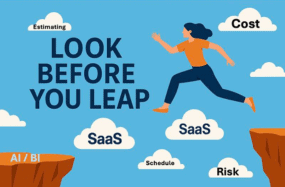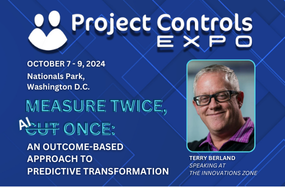
Project Management AI: The CIO’s Mandate to Build an AI-Ready Enterprise

No one’s questioning whether AI has a role in project management anymore. The value is clear: faster decisions, smarter forecasting, fewer costly surprises. But talk to any tech leader actually trying to implement it at scale, and the conversation shifts fast—from potential to roadblock. The consensus is resounding: the roadblock isn’t the AI, it’s the data.
For CIOs in complex environments like AEC capital projects, the path to unlocking AI’s promise isn’t just about piloting new tools. It’s about strategically engineering the conditions that make them work. This starts with treating project data not as a byproduct of operations, but as an enterprise asset, designing systems that integrate instead of isolate, and building a governance model that can scale with confidence.
The “Connective Tissue” Problem: Why Your Digital Stack Isn’t Enough
Most AEC organizations have already done the hard work of digitizing: PMIS platforms, scheduling software, cost control tools, field apps. The stack is there. But what’s missing isn’t more technology—it’s connection.
AI doesn’t need more tools; it needs cleaner, more contextual data flowing seamlessly between the tools you already have. This is the critical “connective tissue” that enables AI models to surface early risks, forecast with precision, and deliver insights teams can truly trust. Without it, AI becomes mere noise, and teams revert to second-guessing reports instead of acting decisively.
Four Data Frictions That Undermine AI in Capital Projects
Every CIO knows the story: big plans for AI, but stalled results in the field. The root cause is almost always in the data flow. These are the four most common friction points we’ve observed across major capital project environments—each one a significant drag on speed, trust, and AI adoption:
- Disconnected Tools: Data remains trapped in PDFs, spreadsheets, and siloed systems across different teams, contractors, and project phases.
- Inconsistent Data Practices: Project inputs vary widely by site or user, making it impossible to spot reliable patterns or train robust AI models.
- Manual Wrangling: Teams waste countless hours cleaning, merging, and validating data laborious processes that must occur before any meaningful analysis can even begin.
- Compliance and Access Roadblocks: Especially on government or critical infrastructure projects, stringent security protocols and audit requirements often gate data access, further complicating integration.
These aren’t just technical hurdles; they are the fundamental friction points that stall AI’s promise, and they represent precisely where CIOs can and must take the lead.
How AI Delivers Tangible Value—When the Data Is Ready
Once project data is centralized, structured, and connected, project management AI stops being theoretical. It starts working, tangibly. This foundation empowers:
- Predictive Schedule and Cost Forecasting: Leveraging historical and real-time data to flag potential overruns long before they appear in traditional reports.
- Automated Issue Detection and Resolution: Identifying subtle risk signals hidden across change orders, RFIs, and schedule updates that human analysts might miss.
- Accelerated Reporting with Reduced Manual Effort: Generating board-ready visuals, exception reports, and trend summaries automatically, eliminating tedious spreadsheet gymnastics.
- Portfolio-Wide Visibility: Applying AI not just to single projects, but across entire capital programs, standardizing insights and surfacing systemic risks that affect the entire enterprise.
The CIO’s Strategic Playbook for Making AI Real
Project management AI isn’t an add-on; it’s a transformation layer. And it only works if the foundation is solid. That means CIOs need to lead strategically in three key areas:
- Data Strategy Alignment: Ensure that capital project data is formally integrated into your enterprise-wide data architecture, rather than remaining an isolated silo.
- Infrastructure Consolidation: Drive the move toward unified cloud platforms where project data can flow securely, efficiently, and with consistent governance.
- AI-Readiness Assessments: Proactively identify which existing data streams are sufficiently structured, trustworthy, and ready for AI modeling—and which require immediate attention and remediation.
The Clear Patterns of AI Success
As organizations increasingly leverage AI in their capital projects, several critical patterns consistently become clear, defining the path to success:
- AI succeeds when project data is reliable.
- Project teams adopt faster when AI insights are trusted.
- Organizations scale better when tech leaders unify the architecture first.
The true value of data analytics in the construction industry, and the promise of AI tools for project management, is directly dependent on data quality, accessibility, and proactive executive alignment.
Ready to Build Your AI-Ready Enterprise?
The future of project management is undeniably linked to AI, but its success hinges on your organization’s data readiness. As a CIO, your mandate is clear: lay the groundwork for true AI transformation.
To assess where your data stands, download our Data Readiness Checklist for AI in Project Management to identify critical gaps and prioritize next steps.
Or connect with us to discuss how to strategically prepare your enterprise for AI-driven project success.
About LoadSpring LoadSpring provides specialized solutions to help CIOs and tech leaders unify project data, reduce risk, and accelerate decision-making. With two decades of experience supporting project delivery in the cloud, we specialize in turning complexity into clarity—so AI and innovation can take root. Our solutions are designed to support artificial intelligence in construction project management by eliminating data silos and enhancing cross-system visibility.








